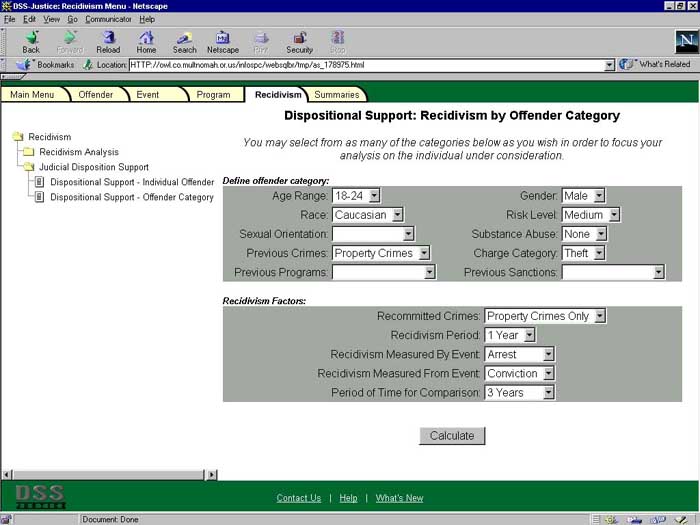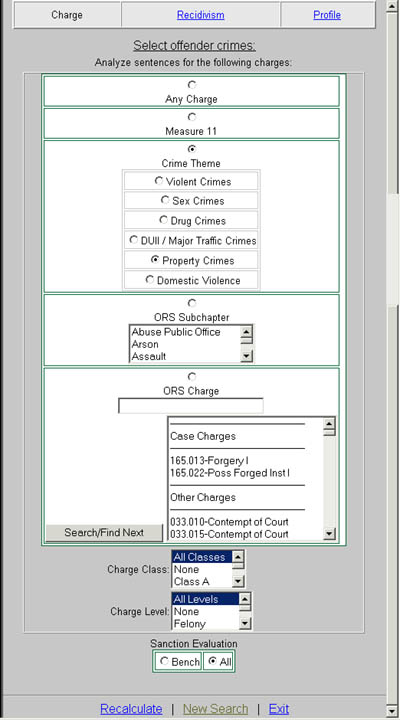BE IT RESOLVED BY THE OREGON JUDICIAL CONFERENCE that in the course
of considering the public safety component of criminal sentencing, juvenile
delinquency dispositions, and adult and juvenile probation decisions, judges
should consider and invite advocates to address the likely impact of the
choices available to the judge on future criminal conduct.

BE IT FURTHER RESOLVED that judges are encouraged to seek
and obtain training, education and information to assist them in evaluating
the effectiveness of available sanctions, programs, and sentencing options
on future criminal conduct.
No. 2 October 25, 1998
Go to issue #1 Go
to issue #2 Go
to issue #3 Go
to issue #4 Go
to issue #5 Go
to issue #6
Introduction
The first issue of Resolution News explained that this newsletter
is offered in the spirit of 1997 Oregon Judicial
Conference Resolution # 1, the conclusions of which are restated above.
That first issue introduced the 1997-98 Sentencing Policy Committee of
the Conference, 1997 House Bill 2229 (1997 Or Laws
Ch 433), the working group established by Executive
Order No. EO 97-18, and the Multnomah County committee (of the Local
Public Safety Coordinating Council) which is developing the tools I've
been promoting to bring answers to "what works?" into courtrooms for sentencing
hearings.
The full text of HB 2229, the executive order, Resolution No. 1, the
first issue of this newsletter, and descriptions of the software already
under development in Multnomah County (including "screen shots" of the
software we will soon be using) are all available (along with related materials)
on this website - click here to return to the home page: 
This issue is to advise you of the progress we've made and again to
invite your input and suggestions regarding this effort to bring criminal
justice into the 20th Century before it's over. Michael Marcus
Great Progress in
Multnomah County
The Evaluation Committee of the Multnomah County Local Public Safety
Coordinating Council was able to direct $1,165,000 of "Bond Technology"
money to the development of DSS (decision support system) technology to
serve the criminal justice community. DSS technology, at least in this
formulation, "extracts" data from a multitude of separate data bases and
deposits it in a "data warehouse." The data is then available for ready
access to a wide range of users.
The energy driving the construction of such a tool is operational energy
- managers want a better view of how the flow of criminal justice events
and tasks affects their resources. "How many offenders of what kind are
in which jail beds for how long?" is a typical operational question.
But this technology offers tremendous analytical power to improve
our performance. Using tools such as "multidimensional on-line analytical
processing" (MOLAP), even computer novices can quickly "mine" existing
data to answer questions such as "which offender characteristics are most
predictive of pre-trial release success under which conditions of release?"
This is the technological evolution which I've been trying to steer
in a direction which will give us information we've never before had when
making sentencing decisions: How have offenders like the one before us
for sentencing fared after being sent to any of the dispositions which
are available for this offender. By "fared" I mean behaved in terms of
future criminal conduct. New arrests or convictions, new person crimes,
new drug crimes, new 911 calls, new probation violation charges within
one, three, or five years are each measures of performance that
I may find useful for different types of offenders. And the "dispositions"
must include both custody and community supervision, as these dispositions
often compete for our attention. Of course, the tools available must allow
us much better information about what these dispositions mean than we now
have - how many days will a 30 day sentence actually keep the offender
out of circulation?
The staff of five now hard at work developing the first DSS sentencing
support tools promise that this sort of functionality will actually be
available in courtrooms starting the first part of 1999. We have had great
support from Chief Justice Carson, Doug Bray, and the information specialists
from OJIN at the state and local level (Carl Ward, Jim Croft, and James
Conlin).
Here are some examples of screens actually in development:

The blanks in the upper rectangle define the category of offender; those
in the lower define the flavor of recidivism by which you wish to compare
possible dispositions. At the outset, you may have to enter the offender's
name or case ID and crimes of conviction in a previous screen, although
this should become automatic in integration with such efforts as the Uniform
Criminal Judgment project.
In any event, after you accept or modify the offender description and
recidivism measure, you will be presented with a screen showing how similar
offenders have done (by your selected flavor of recidivism) after being
referred to (the shorter bars) or graduating from (the longer bars - bigger
is better) the various dispositions available.

This hypothetical screen compares (from left to right) two anti-theft counseling
programs and five and 30 days jail. For better views of these and other
screens, click here: 
In an October 6, 1998, column Robert Landauer of the
Oregonian said of this project:
"As data become more complete, analysis more rigorous and predictions
more accurate, information becomes intelligence. Sentences, definitely
including prison, then might reflect the best return for money spent on
public safety. Logic dictates that the Legislature will make this decision-making
tool available statewide and see that it is maintained and used."
The Working Group under Executive Order No. EO
97-18
The working group established to implement House Bill 2229 at the state
level has spent most of its time in two subcommittees discussing issues
surrounding 1) the production of state-wide decision support tools like
those under development in Multnomah County 2) the possible creation of
a "Criminal Justice Policy Research Institute." In its Interim Report to
Governor Kitzhaber, the working group reported that
"A number of state agencies are already addressing data warehouse initiatives
. . . Access to multiple agency data regarding individuals is essential
to support criminal justice research, management decision making, and some
operational decisions. While the specifics of conducting program effectiveness
measurement have yet to be agreed upon, there is a consensus that a data
warehouse and data analysis tools would be fundamental to that effort.
"The establishment of [a] state criminal justice warehouse is a necessary
step toward total integration of state criminal justice information . .
. [and] would be in concert with a similar initiative at the federal level."
State agencies are watching Multnomah County's progress with great interest,
and there seems to be consensus at the state level that an integrated criminal
justice data warehouse should support precisely the application I have
been promoting at both the county and state levels.
Although there seems to be little likelihood of "new money" in the upcoming
legislative session, hope is running high that the recent federal enthusiasm
for data warehouse technology will produce some federal money sufficient
to take existing agency data warehouse efforts over the hill to an integrated
product. So far, the federal enthusiasm for technology has not realized
the potential of data-driven sentencing, but I hope that federal funding
will provide us with MOLAP tools sufficient for our purposes. It will probably
be up to OJD's Information Services to adapt those tools to give us sentencing
support on a state-wide basis.
Stay tuned.
1997-98 Sentencing
Policy Committee
Pursuant to the second part of 1997 Judicial Conference Resolution #1,
the Chief Justice appointed a "Sentencing Policy Committee"
to report to the 1998 Conference on these questions: "Is it appropriate
for the Judicial Conference to express a position on whether or how Oregon
law affecting criminal sentences or sentencing policy should be modified?
If it is appropriate, should the Conference take such a position, and if
so, what position should the Conference take?"
The Committee consisted of Judges Alan
Bonebrake, Lloyd O'Neal, Rick Haselton, and Michael Marcus (chair); Marion
County District Attorney Dale Penn, George Riemer of the Oregon State Bar,
Mark Gardner (Special Counsel to the Attorney General), and attorney Michael
Phillips. We distributed a questionnaire to all active members of
the conference (we had difficulty obtaining senior judges' addresses available
quickly), and tabulated the results. Full responses are available from
me directly, but here are the tabulations of the 23 responses we received:
| Appropriate ? |
Should we? |
| Yes |
No |
Yes |
No |
| 12 |
10 |
9 |
13 |
The Committee reported to the 1998 Conference:
"The Committee considered the relevant ethical and statutory provisions
and the diverse responses we received. Although several seemed to voice
concern for restoring, protecting or expanding judicial discretion in the
face of mandatory sentencing provisions and the limitations imposed by
the guidelines, and some suggested narrow areas appropriate for comment,
others strongly opposed any role taking a position on whether or how sentencing
policy should be modified."
The Committee concluded:
"While it may be appropriate for the Conference to express a position
on whether or how Oregon law affecting criminal sentences or sentencing
policy should be modified, the Conference should consider the propriety
of taking any position only in the context of consideration of a specific
proposal. No consensus now exists on any policy sufficient to recommend
any proposal."
The committee proposed the following resolution to the full Conference,
which was adopted by vote of the membership:
Be it Resolved that the Criminal Law Committee Shall Perform the
Following Functions:
1. Explore issues arising from the experience of judges with existing
criminal sentencing laws and practices;
2. Monitor legislative and ballot measure proposals for changes in sentencing
policies;
3. Alert the Conference to significant criminal sentencing proposals
and issues and identify means by which Conference members can assist public
and legislative consideration of such matters;
4. Report to the Conference any suggestions regarding the organization,
jurisdiction, procedure, practice and methods of administration and operation
of the various courts as they relate to criminal law, including any recommended
legislation to be proposed to the governor pursuant to ORS 1.840;
5. Suggest to the Conference any matter which should be recommended
to the Chief Justice for consultation with the Criminal Justice Commission
pursuant to ORS 137.654(10); and
6. Propose to the Judicial Education Committee judicial education on
such issues concerning criminal law and sentencing policy as it sees fit.
- MM Return
to Smartsentencing home page Go
to issue #1 Go to issue #2
Go to issue #3 Go
to issue #4 Go
to issue #5 Go
to issue #6


